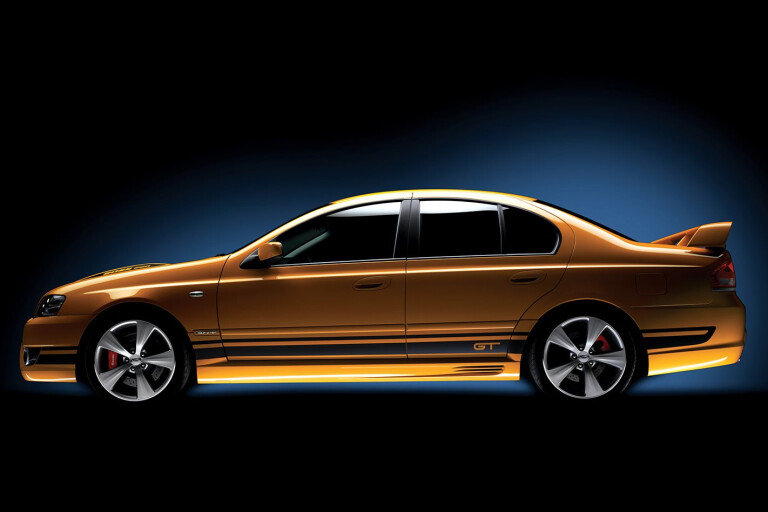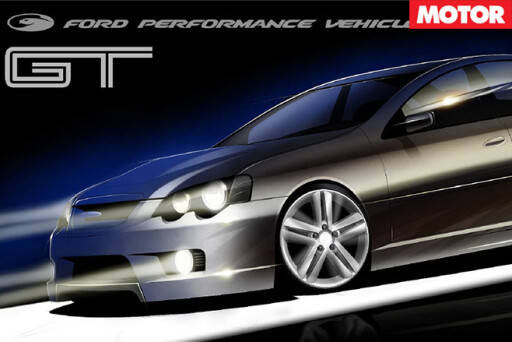
Bringing back the GT badge as an ongoing model with the BA Falcon was the right thing to do.
It required permission, but it was one we won. It was wrong to bring out the badge every few years, make a few and then put it back in the cupboard, I believed. It was a proud emblem and should be paraded as such in Ford’s line-up or honourably retired. And so we brought it back.
That was just one of the highpoints of near 15 years leading the team that gave the Ford Falcon fangs again. There were more hits, and some misses, from an unforgettable period as managing director of Tickford Vehicle Engineering – later Ford Performance Vehicles. But first I have some official business to settle – what actually went down with TVE and FPV, because you shouldn’t believe all that you read.
 In 1991, Tickford Limited, a UK automotive development company, joined forces with Ford Australia to create TVE – an official outpost charged with getting Ford’s performance Falcons firing on all cylinders again – six or eight. Tickford, which posted me to Australia to get the new enterprise up and running, would own 51 per cent, Ford 49 per cent. In a nutshell Tickford would run the projects and do the engineering, testing and homologation.
In 1991, Tickford Limited, a UK automotive development company, joined forces with Ford Australia to create TVE – an official outpost charged with getting Ford’s performance Falcons firing on all cylinders again – six or eight. Tickford, which posted me to Australia to get the new enterprise up and running, would own 51 per cent, Ford 49 per cent. In a nutshell Tickford would run the projects and do the engineering, testing and homologation.
Ford would take care of styling, sales and marketing, and retain final overall sign-off on whatever we built. A crucial point was TVE would finance the development and manufacture of the product – and take on responsibility for designs it had developed and fitted, including any product liability and warranty considerations.
My first job between May and August 1991 was to negotiate the wording of the initial agreement with Ford’s in-house lawyer, the late Noel Woodford. A cunning old boy who, at the last minute, introduced a clause of his own – I had to barrack for Hawthorn!
We signed the shareholder’s agreement in August ’91 and I was appointed Managing Director. We were up and running shortly afterwards and, having overseen the creation of more than 42 high-performance Ford models, from the original XR6 to the FPV GT and the F6 Typhoon, I retired in January 2006.
 The best bits? When both owners of the business agreed to change the name to Ford Performance Vehicles and give us marketing responsibility – and licence to create some cheeky advertising some of you might remember.
The best bits? When both owners of the business agreed to change the name to Ford Performance Vehicles and give us marketing responsibility – and licence to create some cheeky advertising some of you might remember.
Setting up Ford Performance Racing and the construction of the centre at Campbellfield was also a highlight. And it would be remiss of me not to mention the privilege of leading a team that, for creating performance cars, was world class. (There are too many names to mention – you know who you are.)
There was working with world-class leaders the likes of Jac Nasser and Geoff Polites. But also meeting and being befriended by the passionate owners of our cars – the supporters’ clubs being formed in our name, some members of which travelled to our open day in March each year from every state in Australia.
They were as big a fans of the product as we were, and we were proud – still are. My favourite cars include the original XR6 and its subsequent derivatives, especially the turbo versions. The 5.6-litre “stroker eight” in the T3 T-Series was our first donk with real grunt and represented, in terms of building engines, our entrée.
 And there were lows – but fortunately not too many. The F6 Typhoon clutch debacle was the one and only time we launched with a defective product; it was a fantastic car blighted by issues we should have recognised before launch. I approved the product as being fit for launch and that was a serious error. I do take some comfort in the outstanding response from our engineers, dealers and customers; the recall, refit and customer relationship program was recognised as world class.
And there were lows – but fortunately not too many. The F6 Typhoon clutch debacle was the one and only time we launched with a defective product; it was a fantastic car blighted by issues we should have recognised before launch. I approved the product as being fit for launch and that was a serious error. I do take some comfort in the outstanding response from our engineers, dealers and customers; the recall, refit and customer relationship program was recognised as world class.
There was the FPR engine shambles, too. Who did what to whom is not for publication but the damage it did to the race team could have been terminal. We lost Craig Lowndes but the team dug in and recovered to go on to great things.
Mostly, though, it was a blast, and I regret not a minute helping to create performance Falcons that will live on in the care of passionate owners long after lights out on the production line. I arrived in Australia in 1991 thinking we’d be here two years, set-up shop, hire the right people and then head back to the UK. That was only objective not met.

COMMENTS